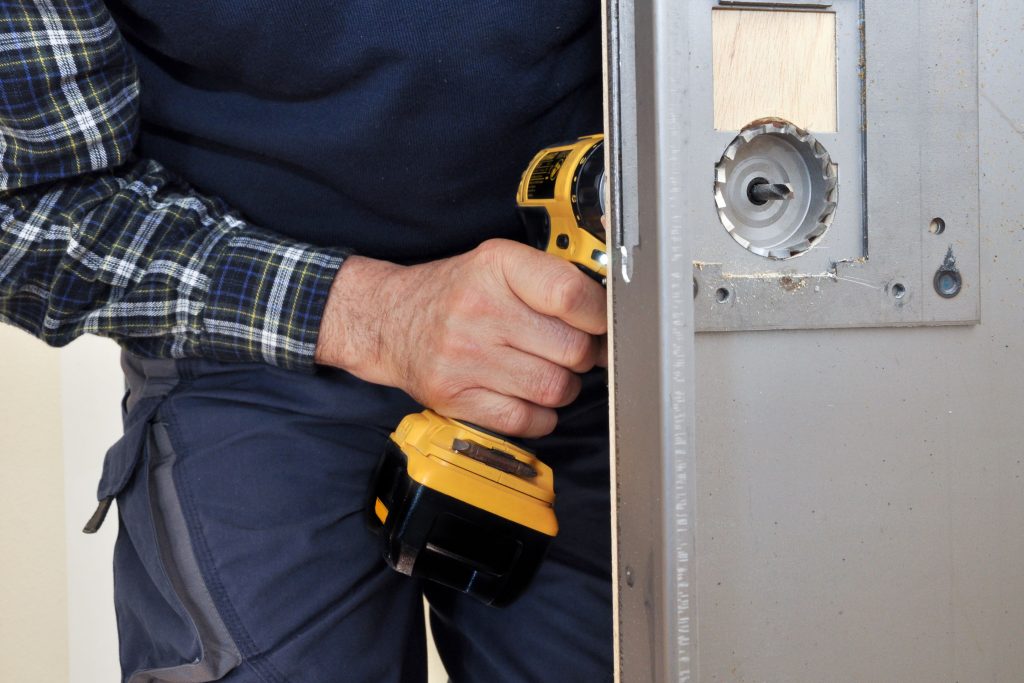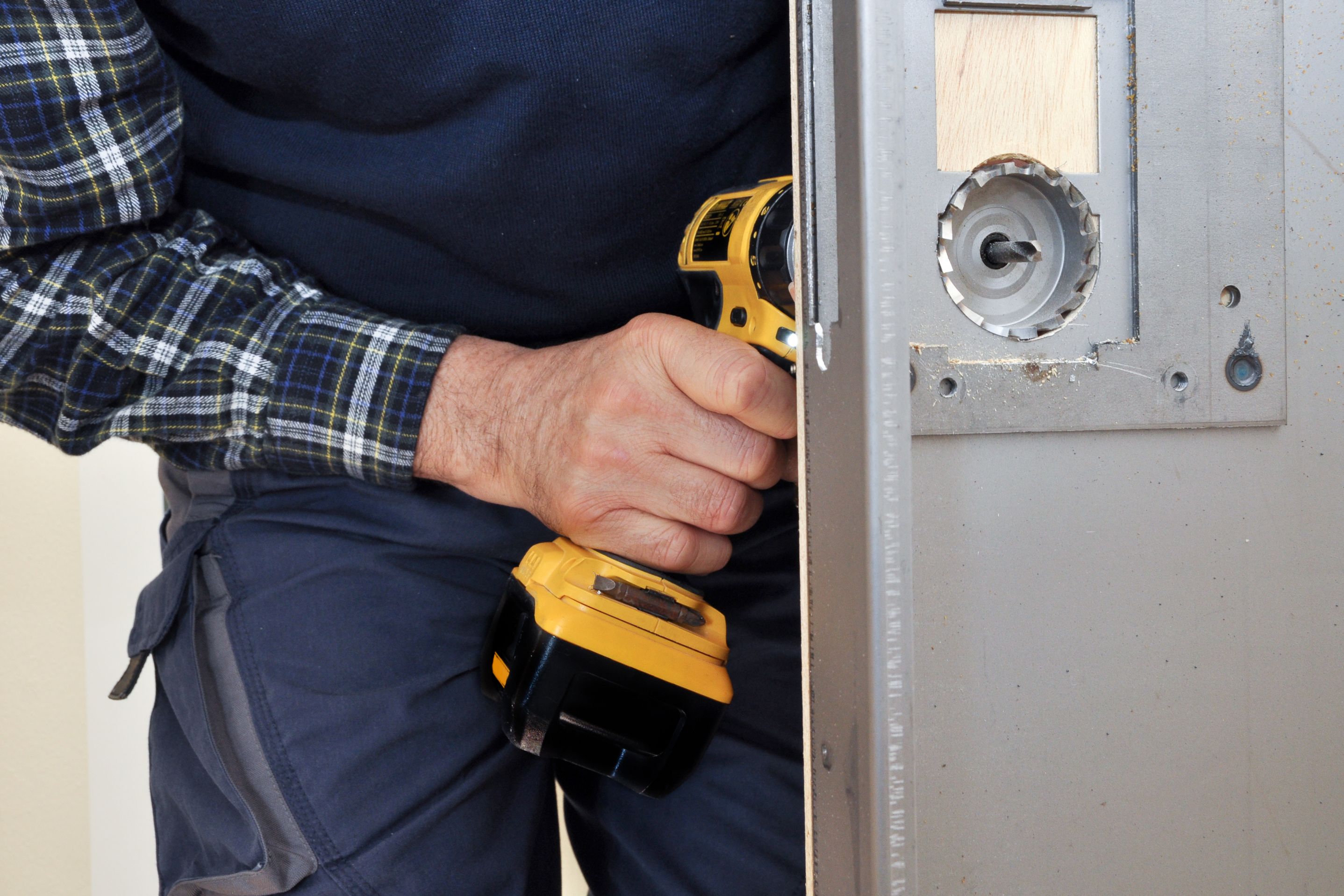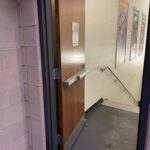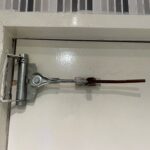This post was published in Doors & Hardware
 I frequently receive questions about alterations of existing fire door assemblies, including preparations for new hardware and filling holes left by hardware that has been removed. NFPA 80 – Standard for Fire Doors and Other Opening Protectives addresses two types of alterations made in the field – job site preparations and field modifications. Information was added to the 2016 edition of NFPA 80 that was not included in previous editions of the standard; those changes are noted below.
I frequently receive questions about alterations of existing fire door assemblies, including preparations for new hardware and filling holes left by hardware that has been removed. NFPA 80 – Standard for Fire Doors and Other Opening Protectives addresses two types of alterations made in the field – job site preparations and field modifications. Information was added to the 2016 edition of NFPA 80 that was not included in previous editions of the standard; those changes are noted below.
Job Site Preparations
Hardware preparations made on the job site are covered under Section 4.1.3 – Appurtenances. The term “appurtenance” is not defined in NFPA 80, but it is generally used to describe subcomponents of an assembly. In the case of a fire door assembly, appurtenances include locks and latches (including electrified hardware), hinges, closers, astragals, and other hardware, as well as glass lights, louvers, plant-ons, and laminated overlays.
Preparations for appurtenances must be performed in accordance with the manufacturer’s inspection procedure and under label service – typically at the manufacturer’s facility or an authorized shop where labels may be applied. In addition, limited preparations may be made on the job site. This section of NFPA 80 limits job site preparations to the following:
- Holes for surface-applied hardware – applied to the door or frame without removing material other than drilling round holes to accommodate cylinders, spindles, and similar operational elements, electrified hardware (added in the 2016 edition), as well as through-bolts.
- Function holes for mortise locks
- Holes for labeled viewers
- Maximum ¾-inch wood and composite door undercutting
- Installation of protection plates
Previous editions of NFPA 80 limit the maximum diameter for round holes drilled in the field to 1 inch, except cylinders which may be drilled in the size necessary to accommodate the cylinder. The 2016 edition includes the same limitation, but a new paragraph was added which allows larger holes for surface-mounted hardware to be drilled in the field in accordance with the listings of the door and hardware manufacturers. The 2019 and 2022 editions are consistent with the 2016 edition in this respect. Before drilling larger holes it is important to verify with the manufacturers whether their listings allow these to be drilled in the field.
NFPA 80-2016 also added a paragraph regarding job-site preparation for raceways drilled across the width of the door to carry wires from electrified hardware to an electric hinge or power transfer. This preparation may be performed at the job site in accordance with the door manufacturer’s listings, and when permitted by the listing laboratory (for example, Underwriters Laboratories or Intertek). If a door manufacturer’s listings do not include provisions for drilling raceways, the raceway is considered a field modification (see below).
Field Modifications
In the 2013 edition of NFPA 80, a definition for field modifications was added: “Changes, not otherwise permitted by this standard, made to a listed assembly or component after it has been manufactured.” This definition, along with additional information in Annex A, make it clear that the acceptable job site preparations listed above are not considered field modifications.
Field modifications are addressed in Section 5.1.4 of the 2013 edition of NFPA 80, and Section 5.1.5 of the 2016 and 2019 editions. For changes made in the field that are above and beyond those allowed as job site preparations, permission may be requested in advance by contacting the manufacturer of the component being modified; the manufacturer will then contact the appropriate listing laboratory with a written or graphic description of the modifications. For example, most electric strikes require a rectangular cutout in the face of the frame. Permission to make this modification in the field may be approved by the listing lab, after permission is requested through the frame manufacturer. Raceways would also require pre-approval if the door manufacturer’s listings do not address raceways drilled in the field.
If the manufacturer of the component being modified is no longer available, the lab may be contacted directly, and an engineering evaluation supporting the field modification may be provided. A field visit from the listing laboratory is not required if permission for the field modification is granted by the lab. If modifications are made without prior approval, the doors and/or frames may need to be re-labeled by the listing laboratory, which will include a site visit and inspection and can be costly.
Filling Holes
Job site preparations and field modifications sometimes result in holes left in the surface of the door or frame due to the removal of existing hardware. In the 2013 edition and prior, NFPA 80 requires holes to be repaired by one of two methods: install steel fasteners that completely fill the holes, or fill the screw or bolt holes with the same material as the door or frame. The standard seems to be addressing only holes from fasteners and this was confirmed in the 2016 edition when the language was changed slightly to state, “When fastener holes are left in a door or frame…”
The 2016 edition also added a third method for filling fastener holes – “Fill holes with material listed for this use and installed in accordance with the manufacturer’s procedures.” This acknowledges the use of caulk or other materials that can be used to fill holes, but only if the material is listed for filling holes in fire doors. If a product has been tested and listed for filling voids in walls or other surfaces, that does not necessarily mean that it can be used to fill holes in fire door assemblies. At this time, there are very few products that have been listed for use in fire doors and there are strict limitations on where it is used; it’s important to verify the manufacturer’s listings regarding the size of the hole, the door or frame material, and the rating of the assembly. While previous editions of the standard did not specifically mention the use of a filler material, it may be allowed as an equivalency (NFPA 80 Section 1.4).
Holes that are not fastener holes are considered a field modification. This means that approval for the repair must be obtained from the listing laboratory, via the door or frame manufacturer. To determine whether an existing hole may be covered by a filler plate, or whether covering existing holes with new hardware is sufficient, the door or frame manufacturer should be contacted to ensure that the proposed solution is acceptable. If alterations are conducted in compliance with NFPA 80, the fire door assembly is not typically required to be re-labeled in the field, but beginning with the 2013 edition of NFPA 80, a fire door assembly inspection must be conducted after maintenance work is completed. The 2013, 2016, and 2019 editions of the standard also require inspections after installation of the assembly, as well as annually.
Conclusion
When preparing to perform a field modification or when questions arise, it’s best to avoid problems by conducting research and planning in advance. While NFPA 80 gives some direction with regard to protocols that must be followed when making alterations in the field, to get definitive answers you may have to contact the manufacturer of the component being modified, or even the listing laboratory on the label. The door or frame label will contain helpful information to identify the manufacturer and testing lab, along with a number which can be used to obtain more detailed specifications. The manufacturer should be the starting point for most requests, and then the listing laboratory. The Authority Having Jurisdiction may also be contacted for assistance.
You need to login or register to bookmark/favorite this content.








How about adding a listing label in the field??
When the door meets all testing criteria and maker comes out to do it???
The only way that can be done currently is by a listing lab like UL, Intertek, or one of the smaller ones. The manufacturers can’t apply labels in the field.
Based on that statement, the common practice of a door and frame Distributor that has a UL approved shop is not allowed to field label filed modifications, without contacting the manufacturer, or listing agency first. They don’t get a blanket authorization because they’re an approved shop.
Only a listing lab can field label. What a distributor / installer can do is to request permission to perform field modifications, and if approved the door / frame would not need to be relabeled.
Interesting, not just with doors, but a few other oddities have seen the manufacture able to apply the labels?
well UL seems to say that you cannot do it and another place seems to allow the manufacture to do it::
Field labeling
Application of a UL Mark in the field
The application of a UL Mark in the field is only permitted when an inspection is conducted in accordance with one of UL’s Field Engineering Services in the presence of a UL representative.
and:::
Field Inspections
If your product or equipment has been recently installed and is missing the proper UL labels, UL’s Field Inspection Service can provide an onsite inspection to allow the product to be field labeled. This service can help you avoid costly removal and replacement of your product, saving you both time and money.
To qualify for this service, the equipment or products should meet the following criteria:
Must have an active UL certification.
Must have been manufactured at a UL authorized manufacturing facility in accordance with the active UL Procedure.
Should not have been in use for more than one year.
In addition, minor modifications performed in the field are permissible on equipment or products provided that the modifications are fully in accordance with the UL Procedure. Such modifications shall be made by the manufacturer authorized in the UL Procedure that covers the equipment or product.
All Inspection, Measuring, and Test Equipment (IMTE) required as part of the UL Follow Up Services Procedure or used in the conduct of the inspection of the product must be provided to our Field Representative by the applicant, manufacturer or on site contact. The IMTE must be calibrated and included in a calibration system.
If you would like to request this service please complete the Field Inspection Application form.
Only the UL Applicant for the file, the Manufacturer of the product, or Distributor may initiate the Field Inspection of a product. If you are not the UL Applicant, the Manufaturer, a Distributor of the product, or if your equipment or products do not meet the criteria for a UL Field Inspection, UL’s Field Evaluation Service may be the solution. The Field Evaluation Service is intended for evaluating installed equipment that has not been previously investigated by UL, or has been significantly modified in the field for the specific installation or application, or modified by other than the original manufacturer. To learn more about this service visit the Field Evaluation Services web site. If you are unsure which service is right for your application please contact UL at 1-877-UL-HELPS and select option #2 from the menu.
The department responsible for the data and design of this application is the Lotus Notes Development Team [Northbrook, IL.]
Use the “Feedback” link in the right navigation bar to send comments or suggestions.
“”””””Only the UL Applicant for the file, the Manufacturer of the product, or Distributor may initiate the Field Inspection of a product. If you are not the UL Applicant, the Manufaturer, a Distributor of the product, or if your equipment or products do not meet the criteria for a UL Field Inspection,””””””
https://ifs.ul.com/fieldinspections/ulfi.nsf
http://site.ul.com/global/eng/pages/offerings/perspectives/regulator/electrical/fieldcertification/fieldmodification/
I’m curious as to how something like a recessed door contact would be addressed by the code. If an opening is to receive a card reader or just a door position switch for alarms from the onset of a project it is typically prepared for at the factory with a mortar box and the holes already drilled. What if it is an existing door, would a 3/4″ or 1″ hole be considered a job site preparation, or would this be considered a field modification requiring the manufacturer of the assembly to be contacted?
In my experience, it’s usually treated as a job site preparation, although the language in NFPA 80 doesn’t technically refer to this type of product because it’s not surface mounted hardware.
I Like the subject and the content. I also Like the question regarding doors contact. But because I know how acces control people work, Im sure NFPA 80 won’t be respected in calling manufacturer for authorization.
Im on a job now where the strike preps where never made on the frame. These frames where installed over 25 years ago. To make the door latch a round hole was drilled in the frame many years ago. The owner wants me to cut a strike prep in the frame and install a strike. There are hundreds of frames with this problem. My question is will me cutting in the strike void the rating on the frame? I work for a distributer and have moved and cut strike preps in hundreds if not thousands of frames in my years of working on doors but the manufacturer authorized this work therefore not voiding the label. These frames im now asking about we didnt supply and the manufacturer is no longer in business. I told the owner this may void the label but he doesnt seem to think so because he says its a minor modification of the frame and were doing the right thing by putting a strike in the frame. If in fact the label is void because of this work who would be liable for fault in case of a fire and the frames are discovered to have been modified? This building is a hospital.
Hi John –
You’re improving the condition of the frame by adding the strike, but technically the strike prep is not within the job site preparations allowed by NFPA 80. I would recommend contacting the listing laboratory on the label and asking for permission to do a field modification.
– Lori
You always have such great articles that are very informative. I use them when training people here. It would be nice to have a print button on the page to give a printable copy view that my people here could put in a binder for quick reference. Keep up the great stuff. Don
Hi Don –
After the article is in Doors & Hardware I upload a reprint to the original blog post which can be printed. Check one out here (look for the link that says “click here to download the reprint…”): http://idighardware.com/2014/07/decoded-calculating-the-occupant-load/
– Lori
In reference to filling holes in frames and doors. Nfpa seems to only address holes through the door and not for surface applied hardware such as a kick plate. If the kick plate is removed nfpa wants screws ground off in the holes? Is bondo ever acceptable for filling holes less than. 1/4″ ?
Hi Keith –
The only product I know of that has been tested for filling holes in fire doors is Fire Door Caulk (http://www.firedoorsolutions.com/products-page/fire-door-caulk/) and I think it’s limited to wood doors.
– Lori
Lori
Was this tested in Canada ?
Can we fill 5/8 of a hole on a fire rated wood door with this fire caulking ??
Hi Nora –
I’m not sure – I would recommend contacting Fire Door Solutions and/or the door manufacturer.
– Lori
Lori,
This does not seem to address using fillers for 86 edge and auto flush bolts on rated doors when retrofitting doors for surface vertical rod devices. Are these types of fillers acceptable or are the cutouts too big?
thanks,
Bob
Hi Bob –
Technically a fire door that is being retrofitted for fire exit hardware has to have a label referencing the fire exit hardware. While I have seen some multi-purpose labels that include information for fire exit hardware and standard latchsets, many labels are specific to the type of hardware originally installed. As far as the fillers, it would be up to the door manufacturer whether those are acceptable. They may be ok for hollow metal doors, but I don’t think they’d be acceptable for wood doors.
– Lori
Hello Lori;
Thank you for the awesome articles you publish and the questions you answer. I have a weird question to ask. We supplied some doors on a job with Cyl lock preps and they changed the hardware to Rim exit devices. The exterior trim is covering the hole entirely and the rim device is too but the inspector is saying that the 2″ hole has to be filled.
can you help on this?
Hi Ken –
I’m assuming these are fire doors. There are 3 issues with changing a fire door with a 161 prep to fire exit hardware.
1) The added preps for the fire exit hardware should not be larger than 1″ diameter holes (or there is an approval procedure to follow). It sounds like you’ve already passed this step.
2) The fire door is supposed to bear a label stating that it will be equipped with fire exit hardware. This ensures that the door is properly reinforced and will perform as designed during a fire. A door with a 161 prep wouldn’t usually have the required label, but some manufacturers now use a multi-purpose label that includes fire exit hardware as an option.
3) The 161 prep is supposed to be filled, but I don’t know of a way to fill a hole this large that will meet the UL/ITS requirements. If it’s a hollow metal door, filling the holes with steel fillers might be acceptable to the AHJ. If it’s a wood door, I don’t know what he will accept.
I hope that helps!
– Lori
would an electric raceway in a hollow metal door for electrified exit hardware required relabeling? The raceway hole is less than 1″ and will be covered by a UL listed wire transfer hinge. In the past we have done several preps in the frame without requiring relabeling. What do you think?
I have asked NFPA this question before, and the general consensus is that a raceway is not allowed as a job-site preparation but can be done as a field modification (here’s an article about these 2 types of preps: http://idighardware.com/2014/10/decoded-alterations-to-fire-door-assemblies/). There is a process for getting permission in advance from the listing laboratory, and there is also a program called the Perfect Raceway which apparently does not require relabeling after the raceway is prepped.
The 2016 edition of NFPA 80 has added some provisions regarding raceways:
4.1.3.2.4 Drilling raceways for wires when performed at the job site shall be in accordance with the door manufacturer’s listing and when permitted by the laboratory with which the door is listed.
4.1.3.2.5 Where the door manufacturer’s listing does not contain provisions for drilling raceways, the raceways shall be considered field modifications in accordance with 5.1.5.1.
The NFPA 80 Handbook says:
With the increased demand to meet building security needs, many building owners and contractors are installing security features on fire doors, such as electrified hardware or access control systems. (See NFPA 101, Life Safety Code, for additional operational requirements for egress doors.) Thus, specific guidance is needed for incorporating electrical hardware into doors. New 4.1.3.2.4 allows drilling raceways for wires when performed at the job site if in accordance with the door manufacturer’s listing and when permitted by the laboratory for which the door is listed. Otherwise, if the door manufacturer’s listing does not contain provisions for drilling raceways, the raceways are required to comply with the requirements for field modifications in 5.1.5.
Nationally recognized guidelines are available for field installation of raceways in wood doors. In addition, there are laboratories that offer training and certification to properly install a raceway without voiding the fire protection rating of the door.
– Lori
Lori,
You mention in the article that “There is at least one tool and certification program available for drilling raceways.”
Is there a source for more information on that particular program?
This is an excellent topic! Thank you for all you do!
Hi David –
This is the product I was referring to: http://www.perfectraceway.com/
– Lori
Lori,
I had a situation where a UL labeled Frame needed the strike plate prep dropped roughly 1 1/2″ requiring cutting the frame.
The UL Listed manufacturer of the frame did the work on site. Is the manufacturer required to seek UL approval in this situation
or is the label still valid because the manufacturer did the work?
Thanks!
JB
Hi Jeff –
Being a manufacturer doesn’t give us any special approval that I’m aware of. I don’t think we are able to modify fire-rated frames in the field without having them re-labeled, unless we have prior approval from the listing lab. I will check with Steelcraft to make sure.
– Lori
Lori,
my supervisor wants me to install a 3″x33″ lite kit in a rated door. If I do and follow his “who will know” comment, what could happen?
Hi Mike –
That’s a tough one. Maybe no one will ever know, but if someone does find out, the door would have to be relabeled in the field or replaced. Both are expensive options. Most installers and locksmiths that I know will refuse to modify a fire door in a manner that’s not code-compliant, because of the perceived liability, but I don’t know of specific examples where someone has been held liable for cutting a glass light into a fire door in the field. The door should really be taken to an authorized shop, modified, re-labeled, and re-installed.
– Lori
Lori,
I have some A60 steel doors made in Sweden. I live in the USA. There may have been a post manufacturer mod to the doors: a two inch circle with a swing plate on it. Flanges all look factory made but clearly a hole in a fire door. I want to remove and repair but how do I find a shop to do this work? I see you talk about authorized shops but I assume you mean authorized by manufacturer. Thanks for you efforts. This is a great resource. PS I am thinking we have to replace these doors.
Hi Paul –
The authorized shops are authorized by the listing lab – like UL or Intertek. I’m wondering if your doors are listed to UL 10C / NFPA 252 as required by the US codes, and it also sounds like the modification is questionable. If you want to send me a photo I’ll have a better understanding of the situation. lori.greene@allegion.com.
– Lori
What about door mounted sensors such as Bea LZR or Optex pro swing elite. The both sensors require you to drill a 1/4″ hole and run a sensor cable through the door. Is this acceptable?
Second question which is kind of related is regarding electrified transfer hardware. If a door was originally installed with an electrified continuous hinge, is a surface applied armored loop cable from the frame to the exit devices ever acceptable?
Hi Ryan –
The sensor would have to be listed for use on a fire door assembly, and my understanding from UL is that if the installation instructions show a field prep, it is allowed. With that said, NFPA staff gave me different information on that.
We recently had our door loops certified for use on a fire door, and at the time I was told by our engineers that the door loop had to go from the frame to the door – not from the frame to the hardware.
– Lori
Hi Lori
Pls can you explain a little more what kind of modifications are allow to be done on a fire rated door by an authorized shops.
The modifications allow are describe on the NFPA 80 ??
Hi Edgar –
Authorized shops have a list of procedures that they are authorized to perform. These modifications go beyond what is allowed by NFPA 80 as a job-site preparation. For example, when I worked for a distributor our shop was able to prep for mortise lock pockets, cut in glass lights, reduce the size of a door, build sidelight frames, etc. But the work must be performed in the shop and then the label applied to the finished product.
– Lori
I have a situation where we have a hand-reader that operates an electric strike on a fire rated opening. Mortise lockset is a storage function. Owners want to remove the reader and make the door a passage function instead. Swapping out the lockset is no big deal but, they want me to remove the electric strike as well. So, it can be used in another location as it is fairly new and expensive to just sit in the frame and do nothing. I told them I cannot remove it as it will invalidate the fire rating on the opening. Do you know if there happens to be a product that could take the place (fill the void) of the electric strike that would still latch the door and keep the fire rating? Thanks.
Hi Chad –
There are electric strike filler plates (http://don-jo.com/), but I’m not sure if there is one that is prepped for a strike for the passage set. Your best bet is to contact the frame manufacturer and see what their listings would allow.
– Lori
Hello ,
I would like to ask what type of filler may be used when installing the mortise lock. So happens that the manufactured pre-drilled a 1/4” depth more than needed and the plate goes in a bit not flush with door.
Can this be done on site this would be a 45 minute fire rated laminated door.
Hi Hiram –
I would recommend asking the door manufacturer what to do that will be in compliance with their listings. because this is not specifically addressed in the codes or standards. I have seen installers double-up the scalp plate on the lock, but this reduces the latch throw so it could affect the performance of the door during a fire.
– Lori
Lori,
I use your forum for a resource and am very grateful you do this.
My question is this. (sorry if it has been answered, I looked and couldn’t find it)
Can you cut an electric strike into a fire rated frame in the field? Specifically, A Von Duprin 6210 going into a 90 minute Steelcraft F16 frame? This would require cutting the rectangle out of the face of the frame. I have been told by Reps of the manufacturers that this is acceptable and want to make sure.
Thanks,
Jim
Hi Jim –
NFPA 80 limits job-site preps to round holes, so in my opinion, any other type of cutout would need approval from the listing lab to be done as a field modification.
– Lori
I have a situation where there is an existing fire rated door and frame leading to a stairway, they are replacing the door due to possible asbestos ,and they want to add an exit device to the door. the new doors were ordered, they came with wrong hinge cutouts, so we are installing fire rated continuous hinges,will this affect the the rating of the frame. The frame does have a label on it
Hi Frank –
You can double-check with the door and frame manufacturers, but typically it is acceptable to install continuous hinges without affecting the rating. The hinge preps need to be filled in a way that is acceptable per the manufacturers’ listings. I wrote a blog post on this a long time ago, but I think the info is still correct: https://idighardware.com/2013/03/qa-continuous-hinge-retrofit/.
– Lori
Love that this article was written in 2017 and here I am in 2022 posting new questions. We had an instance on a project where the door installer had to sand a door to achieve the required hinge/head gaps for a fire rated door and frames per NFPA 80 and LAWA standards. Would the sanding of the door constitute a modification? Inspector is of the opinion it does, but the installer is pushing back as relabeling/inspecting are expensive. Unfortunately if this does meet the definition of a modification it was done prior to contacting anyone. Great Article.
That’s a great question. I will ask a few people if they have ever run into that, and I’ll get back to you.
– Lori
I checked around a bit, and the amount of sanding that might be acceptable is impossible to quantify. The best thing to do is to check with the door manufacturer about the specific door that was sanded, and see if this modification would be allowed by their listings. Technically, NFPA 80 doesn’t permit sanding or trimming a door in width as a job site preparation, and any alterations that are not job site preparations are field modifications.
– Lori
Im hoping someone can help me out. A customer wants me to replace a motise lock with a rim mounted strike. Do i need to fill the gap left from the original cutout or is it ok to leave? the rim strike is fire rated.
Hi Marty –
If you send me a photo I might be able to give you a better answer (lori.greene@allegion.com) but typically there can’t be any gaps or holes in fire doors or frames.
– Lori
Did lamination (1.3mm PVC or similar material) permit the steel fire door?